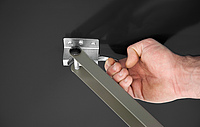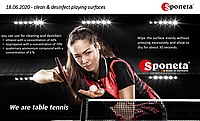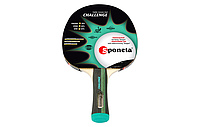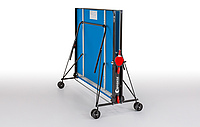table tennis wiki
Change method (Time game)
Time game (colloquially for change method) is used when one set has not been finished after 10 minutes and within this set have not been played at least 18 points. With the change method the right to serve is changing after each point. The winning point is given as in the normal match – with one exception: when the opponent of the server has returned the ball 13 times successfully he gets the point. This means the ball is played back and forth 13 times maximum. For further sets to be played the change method is used again.
Clasp system
The clasps serve for the stabilisation of the stand legs in the storage as well as in the playing positions. By lifting the metal hook, the safety devices unlock themselves and the stand legs of the table can be folded inward. Through a strong push of the metal stick, the diagonal support clasps lock audibly into place.
In use in: S 7-22/23
Class, GS
Table tennis tables are subject to the German Equipment and Product Safety Act (GPSG). All products manufactured by Sponeta are labelled with the GS mark as a quality test proof (tested safety). They are divided into several classes according to their range of application:
Class A - High competition
Class B - School and club sports
Class C - Recreational sports (high quality)
Class D - Recreational sports
clean & desinfect playing surfaces
Comfort Handle (Bats)
On the shortened grip a semicircle made out of EVA is attached. The game becomes much more comfortable and "more smoothly" by this foam-end.
Compact table
Movable table with undercarriage for both halves of the table, each of them is independently foldable. Characteristics of the storage position: Distance of table halves is about 100 mm, storage height is about 1650 mm (Type 4b, in use in S 1-42/43, S 1-72/73, S 2-72/73, S 3-72/73, S 3-80/87, S 4-70/72/73, S 5-70/72/73, S 7-62/63, SDL)




